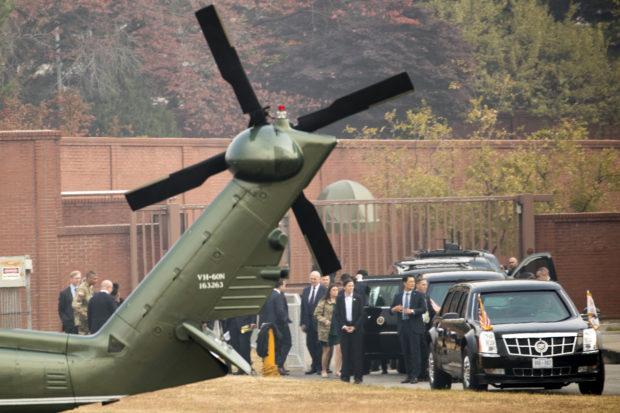
President Donald Trump sits in his presidential limo as Chief of Staff John Kelly, White House press secretary Sarah Huckabee Sanders, both at center, and other members of the administration try to wait out a bad weather call at U.S. Army Garrison Yongsan, Seoul, South Korea, Wednesday, Nov. 8, 2017. Marine One turned back because of a bad weather call just minutes away from visiting the Demilitarized Zone (DMZ), the tense military border between the two Koreas. Trump is on a five country trip through Asia traveling to Japan, South Korea, China, Vietnam and the Philippines. Also pictured is United States Forces Korea Commander Gen. Vincent Brooks, second from left. AP
SEOUL, South Korea — It was the big surprise that was not to be.
Donald Trump, America’s showman president, hatched a secret plan to visit the Korean Peninsula’s demilitarized zone before he ever left Washington last week on a five-nation tour of Asia, the White House said.
Trump teased a show-stopper during a toast at a state dinner being held in his honor in Seoul on Tuesday night, promising: “We’re going to have an exciting day tomorrow for many reasons” that “people will find out.”
With reporters sworn to secrecy and a beefed-up security retinue in tow, his helicopter took off in the dim early morning light Wednesday bound for the heavily fortified border.
Press Secretary Sarah Huckabee Sanders had announced the destination by scrawling the letters “‘DMZ” on a notepad, saying that was how she was told to communicate the sensitive information.
But plans for the grand reveal were botched by Mother Nature, and Sanders described Trump as disappointed — and “pretty frustrated.”
Just after daybreak, Trump’s motorcade had departed unannounced for Yongsan Garrison, a U.S. Army base in Seoul, where a fleet of military helicopters was standing by for the roughly 35-mile flight to the DMZ. Trump had been scheduled to arrive at Observation Post Ouellette, the closest post to the 1953 armistice line, where he would follow his three direct predecessors in peering into North Korea.
But visibility below one mile and misting conditions determined otherwise. Trump was traveling in a five-helicopter air convoy, consisting of two identical VH-60Ns — Marine One and a decoy — and three Chinooks carrying press, aides, and heavily-armed security.
As they neared the DMZ landing site, the pilots were unable to see the other helicopters around them, Sanders said. Military pilots, in conjunction with the U.S. Secret Service, decided it was unsafe to continue, and the helicopters reversed course and returned to Yongsan.
Undeterred, Trump waited nearly an hour in his armored limousine near the helicopters in hopes of a clearing in the weather, but none was forthcoming. White House staff, including Sanders and chief of staff John Kelly, passed the time making frequent glances at the overcast sky.
Just before 9 a.m., the final call was made: the stop was off. Trump’s 11 a.m. address to the South Korean National Assembly could not be delayed to accommodate a later trip. Trump had also been scheduled to visit with families of diplomats at the U.S. embassy in Seoul, but first lady Melania Trump filled that engagement.
Trump was set to depart Seoul for Beijing, China after the Assembly address. The elaborately choreographed arrival ceremony there, which has been timed to sunset, meant Trump could not afford to visit the DMZ later Wednesday.
In advance of the 12-day trip, White House officials had publicly dismissed the idea of a visit to the DMZ as “a little bit of a cliché.” But behind the scenes, Trump made clear to aides he intended to follow through with the presidential rite of passage.
Shrouded in secrecy and symbolism, presidential visits to American troops stationed in South Korea and the DMZ have become a staple of trips to the peninsula for decades. Every president since Ronald Reagan has visited the 1953 armistice line, except for George H.W. Bush, who visited when he was vice president. The show of bravado and support for one of America’s closest military allies has evolved over the years to include binoculars and bomber jackets.
South Korean President Moon Jae-in was set to join Trump at the DMZ, but was diverted as well. The South Korean leader landed at an alternate site about a 20-minute drive from the DMZ, but that was not a possibility for Trump, given the logistics of moving his larger motorcade along streets that hadn’t been secured.
“For President Moon and President Trump to go to together would have been historic, it was supposed to be a symbol of the strong alliance,” Sanders said once Trump returned to his hotel. “I think the fact that they were both planning shows the importance.” /cbb